What Is WiFi 6 (802.11ax)?
Wi-Fi 6, also known as 802.11ax, is the latest Wi-Fi industry standard after Wi-Fi 5 (802.11ac). Before the release of Wi-Fi 6, Wi-Fi standards were identified by versions from 802.11b to 802.11ac. Later, the Wi-Fi Alliance decided to make the Wi-Fi standards easier to understand and remember, and therefore renamed them in a manner similar to the different generations like 3G, 4G, and 5G in mobile communications.
Wi-Fi 6 introduces various new technologies, such as orthogonal frequency division multiple access (OFDMA), uplink/downlink multi-user multiple-input multiple-output (UL/DL MU-MIMO), BSS coloring, and Target Wake Time, significantly improving performance. In this manner, Wi-Fi 6 supports four times higher bandwidth and concurrency than Wi-Fi 5. Additionally, Wi-Fi 6 provides lower latency and better energy-saving capability than Wi-Fi 5.
What Problems Does Wi-Fi 6 Try to Solve?
Wi-Fi 6 is designed for high-density wireless access and high-capacity wireless services, such as in outdoor large-scale public venues, high-density stadiums, indoor high-density wireless offices, and electronic classrooms (e-classrooms).
In these scenarios, the number of STAs on the Wi-Fi network increases sharply within a short time. Furthermore, growing voice and video traffic also poses a requirement on network adjustment. Some services are sensitive to bandwidth and latency. For example, 4K video streams demand per-user bandwidth of 50 Mbit/s, voice streams necessitate latency of less than 30 ms, and VR streams require per-user bandwidth of 75 Mbit/s and latency of less than 15 ms. If long transmission latency is caused by network congestion or retransmission, user experience will greatly deteriorate.
Althrough Wi-Fi 5 (802.11ac) delivers high bandwidth, the ever-increasing access density causes a bottleneck in its throughput performance. Wi-Fi 6 introduces technologies such as OFDMA and UL/DL MU-MIMO. As such, Wi-Fi 6 achieves a four-fold increase in the bandwidth, speed, and user concurrency, while providing lower latency. For example, when there are more than 100 students in an e-classroom, a Wi-Fi 5 network may be faced with great challenges in video transmission and uplink/downlink interaction, but this will no longer be a problem in Wi-Fi 6.
Wi-Fi 6 vs Wi-Fi 5
Compared with Wi-Fi 5, Wi-Fi 6 stands out not only in the faster speed but also in user performance improvement in high-density scenarios.

WiFi 6 vs WiFi 5
Faster Speed
Over the last 20 years, Wi-Fi has become exponentially faster. Wi-Fi 6 leverages various "speed boosters", such as higher-order 1024-QAM, more subcarriers and spatial streams, and longer symbol duration (3.2 us -> 12.8 us per STA), to provide a theoretical speed of 9.6 Gbit/s at the 160 MHz channel width, nearly 900 times faster than the first generation of Wi-Fi.
Higher Concurrency
To support high concurrency, Wi-Fi 6 introduces multi-user technologies, such as OFDMA and uplink MU-MIMO, to improve spectrum utilization. Compared with Wi-Fi 5, Wi-Fi 6 supports four times the concurrent connections.
Lower Latency
OFDMA and BSS coloring technologies introduced in Wi-Fi 6 reduce latency to as low as 20 ms. OFDMA reduces channel conflicts and improves spectrum utilization, and BSS coloring reduces co-channel interference. Unlike Wi-Fi 5 (30 ms latency), Wi-Fi 6 meets the latency requirements of emerging applications such as VR/AR, panoramic live broadcast, interactive gaming, immersive conferencing, and HD wireless projection.
Energy-Saving
As IoT terminals are widely used, Wi-Fi 6 focuses on power consumption of terminals in addition to the speed improvement.
Wi-Fi 6 uses Target Wake Time to save power by waking terminals up on demand. Target Wake Time, together with 20 MHz-only technology, further reducing the power consumption of terminals.
Core Technologies of Wi-Fi 6
Some of the Wi-Fi 6 highlights are described as follows:
OFDMA
Before Wi-Fi 6, OFDM was leveraged for data transmission, and users were distinguished by time segment. During each time segment, one user occupies all channel resources and sends a complete data packet.
OFDMA is a more efficient data transmission mode introduced by Wi-Fi 6. It is also referred to as MU-OFDMA since Wi-Fi 6 supports UL and DL MU modes. This technology enables multiple users to reuse channel resources by allocating subcarriers to various users and adding multiple access in the OFDM system. To date, OFDMA has been utilized in 3GPP Long Term Evolution (LTE) among numerous other technologies. In OFDMA mode, channel resources are shared by multiple users rather than being exclusively occupied by a single user, improving spectrum utilization.
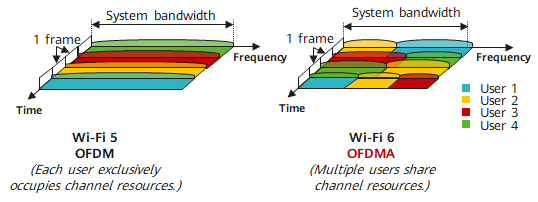
OFDMA technology supported by Wi-Fi 6
UL/DL MU-MIMO
MU-MIMO uses spatial diversity of channels to transmit independent data streams with the same bandwidth. Unlike OFDMA, all users use all bandwidth resources, which brings multiplexing gains. Limited by the antenna size and quantity, a terminal typically supports only one or two spatial streams (antennas), which is less than the number of spatial streams (antennas) on an AP. Therefore, MU-MIMO technology is introduced to enable an AP to transmit data with multiple terminals at the same time, which greatly improves the throughput.
MU-MIMO has been introduced in Wi-Fi 5, but Wi-Fi 5 supports only 4x4 DL MU-MIMO. Wi-Fi 6 supports 8x8 UL/DL MU-MIMO.
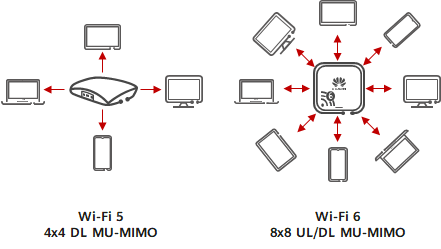
UL/DL MU-MIMO technology supported by Wi-Fi 6
Although Wi-Fi 6 allows OFDMA and MU-MIMO to work at the same time, they are different. OFDMA allows multiple users to subdivide channels (subchannels) to improve the concurrency efficiency. MU-MIMO allows multiple users to use different spatial streams to increase the throughput. The following table compares OFDMA and MU-MIMO.
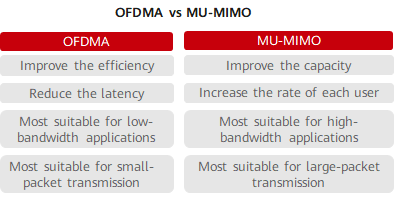
Comparison between OFDMA and MU-MIMO
Spatial Reuse and BSS Coloring
802.11ax introduces a new co-frequency transmission identification mechanism called BSS coloring. The BSS color field is added to the PHY packet header to color data from different BSSs and allocate a color to each channel. The color identifies a BSS that should not be interfered. The receiver can identify co-channel interference signals and stop receiving them at an early stage, thereby avoiding waste of transceiver time. If the colors are the same, the interference signals are considered to be in the same BSS, and signal transmission is delayed. If the colors are different, no interference exists between the two Wi-Fi devices. They can then transmit data on the same channel and at the same frequency. In this mode, the channels with the same color are kept far away from each other. Such signals can be configured to be insensitive, implementing spatial reuse.
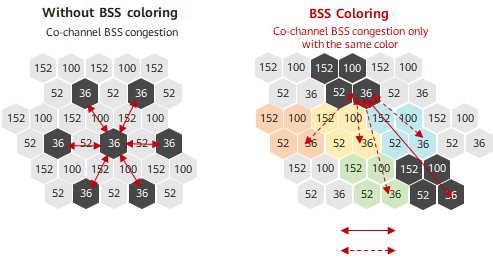
BSS coloring supported by Wi-Fi 6
Target Wake Time
Referencing from 802.11ah, Target Wake Time is an important resource scheduling function supported by 802.11ax. It allows STAs to negotiate with APs for the waking schedule and then send or receive data. APs can group STAs by TWT period to reduce the number of STAs that simultaneously compete for the wireless medium after wakeup. In addition, Target Wake Time increases the STA sleep time. For battery-powered STAs, battery life can be significantly improved.

Target Wake Time supported by Wi-Fi 6
Higher-Order Modulation (1024-QAM)
The Wi-Fi 6 standard aims to increase the system capacity, reduce the latency, and improve efficiency in multi-user high-density scenarios. However, high efficiency is not mutually exclusive with the fast speed. Wi-Fi 5 uses 256-QAM, and each symbol transmits 8-bit data. Wi-Fi 6 uses 1024-QAM, and each symbol transmits 10-bit data, with an increase of 25%. Therefore, compared with Wi-Fi 5, Wi-Fi 6 increases data throughput of a single spatial stream by 25%.

1024-QAM supported by Wi-Fi 6
Support for the 2.4 GHz Frequency Band
The 2.4 GHz frequency band is narrow, and only three 20 MHz channels (1, 6, and 11) do not interfere with each other. The 2.4 GHz frequency band has been abandoned in the Wi-Fi 5 standard. However, it is undeniable that 2.4 GHz is still an available Wi-Fi frequency band. It is still widely used in many scenarios. Therefore, in the Wi-Fi 6 standard, the 2.4 GHz frequency band is supported to make full use of the advantages of this frequency band.
802.11ax Range
The Wi-Fi 6 standard uses the long OFDM symbol transmission mechanism. The data transmission duration increases from 3.2 us to 12.8 us. A longer transmission duration can reduce the packet loss rate of STAs. In addition, Wi-Fi 6 can use a minimum of only 2 MHz bandwidth for narrowband transmission, which reduces noise interference on the frequency band, improves the receiver sensitivity of STAs, and increases the coverage range.
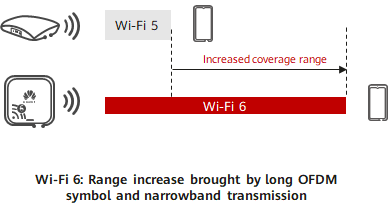
Range increase brought by long OFDM symbol and narrowband transmission in Wi-Fi 6
Wi-Fi 6 Devices
Huawei launched its first Wi-Fi 6 AP in October 2017. Subsequently, Huawei launched a full range of all-scenario AirEngine Wi-Fi 6 products to build digital, wireless, and IoT office and production spaces in various industries, including enterprise, education, finance, healthcare, government, manufacturing, commerce, and stadium.

Huawei AirEngine series APs
Huawei AirEngine series APs include:
- AirEngine 8760 series: Huawei's flagship indoor Wi-Fi 6 APs suitable for high-density and high-bandwidth scenarios in large enterprises
- AirEngine 6760 series: Huawei's indoor AirEngine Wi-Fi 6 APs suitable for high-density deployment scenarios in large and midsize enterprises
- AirEngine 5760 series: Huawei's indoor AirEngine Wi-Fi 6 APs suitable for mobile offices of small and midsize enterprises, business, and retail scenarios
- AirEngine 8760R series: Huawei's flagship outdoor Wi-Fi 6 APs suitable for high-density scenarios such as large enterprises, stadiums, and public venues
- AirEngine 6760R series: Huawei's high-performance outdoor Wi-Fi 6 APs suitable for various outdoor scenarios such as squares, parks, and pedestrian streets
For more product information, see WLAN AC and Fit AP Product Documentation.
- Author: Zhou Xia
- Updated on: 2022-11-23
- Views: 33391
- Average rating:







